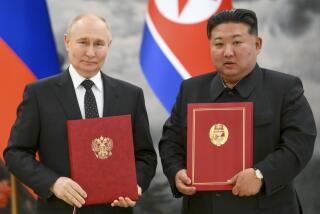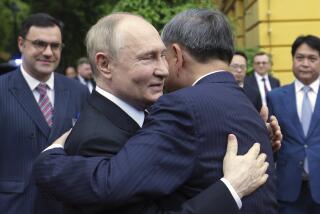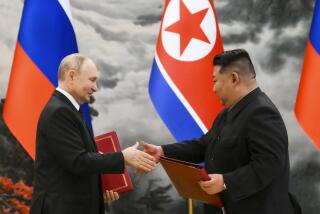PACIFIC REPORT : Moscow Courts Asia Ties : Commerce: The Soviet Union, which long viewed the area as a source of danger, is soliciting its Far East neighbors for investment and economic assistance.
- Share via
Ever since Genghis Khan, Russians have known little but trouble from Asia. Japan sank their fleet in 1905. Mao Tse-tung betrayed them. Tokyo claims Soviet-held islands, and Taiwan’s and South Korea’s economic successes have made old Kremlin theories look silly.
While almost everyone in the Pacific Basin was taking a Chamber of Commerce view of the region, Moscow had 50 divisions deployed along the Chinese border and a massive Pacific fleet. The shooting down of Korean Air Lines’ Flight 007 over Sakhalin Island was consistent.
To Kremlin eyes, the Pacific region offered danger, a place to avoid--except when armed.
Now, with fanfare, all that is changing.
With the Soviet economy in a downward spiral, inflation mounting, the consumer market failing, the ruble virtually worthless and the budget deficit expanding, Moscow sees Asia as the home of nations growing richer in capital and technology. Even its old nemesis, China, is sufficiently well off to have offered Moscow food aid.
Moscow wants to get aboard. For its own economic salvation, the Kremlin is cultivating greater economic ties with Pacific Rim partners--soliciting trade, credits, investment, economic assistance, technology and joint ventures regardless of ideological lineage.
Toward these ends, Soviet President Mikhail S. Gorbachev has met with the leaders of South Korea and China, and this month he will meet with Japanese Prime Minister Toshiki Kaifu as the first Soviet leader to visit Japan. Soviet trade with South Korea and China is rising, and the two countries have extended credit. And it’s not a one-way street; with South Korea, for example, the Soviets have offered to trade technology for consumer goods.
In addition, Moscow would like to see the Soviet Far East’s natural resources and other assets developed, even though it means joint ventures with foreign corporations. To some extent, U.S. companies already play a role--Alaska Airlines is starting regular tourist flights to the Soviet Far East this June--and more new ventures are in the cards.
With their old empire of Eastern Europe gone, Asia is a logical place for the Soviets to turn for a nearby market, as well as labor, capital and know-how. And as the Soviet Far East opens up, U.S. companies may find more opportunities. The area is said to be rich in still-unexplored oil and gas reserves.
A Soviet Union more integrated into the Pacific Rim not only represents trade and investment possibilities. As the Soviets reduce military strength in Asia--Soviet army units on China’s border are already down--they will further lower tensions.
For the United States, that will mean less pressure to maintain so strong a security presence of forces and bases in South Korea, the Philippines and elsewhere in Asia.
“Over the next five to 10 years, there will be substantial opportunities for foreign companies to participate in the Soviet Far East,” predicts James P. Dorian, a research associate who concentrates on Soviet-Pacific Basin affairs at Honolulu’s East-West Center. This is more likely to happen sooner if the Soviet Union stays unified, he said.
“But even if it starts coming apart--if two or three republics go independent--it is not necessarily the end of the matter unless civil war breaks out,” Dorian said. “The republics will just act in a more independent way.”
Moscow, of course, has not given up on Europe. While the Soviet Foreign Ministry’s top expert on Asia, Igor Rogachev, referred in a recent article to the Soviet Union sharing an “Asian common home” with the peoples on its eastern borders, Gorbachev has spoken of sharing “a common European home” with all of Europe.
Not everybody is happy with Moscow’s accommodations in the East. North Korea is bitter over Moscow’s rapprochement with Seoul, China is unsettled over Soviet dealings with Taipei and Soviet conservatives at home are leery of military dilution in sensitive areas, such as on the Chinese border.
Nonetheless, the trend probably will continue. In a vivid demonstration of how important Soviet leaders perceive the region to be for their country’s future, Gorbachev and his political archrival Boris N. Yeltsin are conducting parallel and possibly conflicting efforts to woo the Japanese.
Nobody has favored development of Soviet-Pacific Basin relations more strongly than Gorbachev, who chose Vladivostok in 1986 as the site of his first major foreign policy address and focused his speech on the importance of Asia in the Soviets’ overall scheme.
By 2000, he predicted, Soviet trade with the Pacific Basin--now only 8% of the nation’s total foreign trade--would triple.
“From the beginning, Gorbachev has taken the view that the Soviet Union has a Pacific destiny,” said Mark J. Valencia, research associate at the East-West Center.
Asia not only has much to offer in resources and technology; it may also be much easier for Moscow to do business with Asians than with Americans and some Europeans.
“There’s a school of thought in Moscow that says it will be a very long haul before relations with the West bring the involvement our economy needs, and that it will take less time to build such partnerships in Asia,” Vladimir Pozner, the Soviet commentator and author, said on a recent visit to Los Angeles.
An American obstacle, he said, was the U.S. commitment to human rights, which makes normalization of trade difficult from the Soviet viewpoint. “With Korea and Japan, we don’t encounter such restrictions,” Pozner said, referring to the U.S. denial of “most favored nation” trading privileges to the Soviet Union.
Whether an overthrow of Gorbachev or seizure of power by Kremlin conservatives would affect the course of events is unknown. But the momentum is accelerating without letup:
* This month, traveling through 11 time zones from Moscow to Tokyo, Gorbachev will visit Japan even though the emotional “Northern Territories” issue that has prevented earlier summits--Soviet occupation of the Kuril Islands north of Japan--is yet to be resolved.
Gorbachev is expected to discuss yielding authority over the islands in exchange for Japanese economic aid. In anticipation of regular shipping service--and greater trade--Soviet officials have agreed to open to Japanese ships two of their Far East ports: Korsakov on Sakhalin Island and Vanino in the Maritime Province, a terminus of the Trans-Siberian railroad.
* Last month, Moscow accepted from China a “commodity loan” of $733 million--basically, food aid. That climaxed two years of improving relations that began with Gorbachev’s historic visit to Beijing in May, 1989, ending three decades of open hostility.
Trade between China and the Soviet Union--whose leaders may meet in Moscow in May--has increased to $4.7 billion last year from $3.3 billion in 1988. That included the exchange of Soviet military and nuclear plant equipment for light industrial goods and agricultural products.
* Three months ago, the Kremlin exchanged ambassadors with former anathema South Korea, provoking the charge of “treason” from North Korea. In December, South Korean President Roh Tae Woo, accompanied by 20 industrialists, visited Moscow and discussed trade.
Seoul has extended a $3-billion line of credit to Moscow, an ironic twist from a nation reduced to dust with Soviet arms by North Korea and China in the 1950-53 Korean War. The giant Korean conglomerate Hyundai has set up a permanent office in the Soviet capital plus several small joint ventures involving timber and furniture production on the Kamchatka Peninsula.
Trade between the two countries doubled in 1989 to $600 million and jumped last year to more than $1 billion.
To South Koreans, Moscow offers the hope of technology that neither the United States nor Japan will provide at a price South Koreans want to pay. This includes core technology in lasers, aviation and space, biomedicine and composite materials.
“The Soviet Union has advanced science and technology that we need, and we can provide consumer goods and facilities,” Roh said after his Soviet visit. “If we combine Soviet advanced technology and South Korea’s application know-how, we both can profit.”
* From virtually zero relations in 1989, Moscow and Taiwan last year began official trade and visitor exchanges, including a Russian baseball team in a Taipei world tournament. During the year, two-way trade reached $165 million and an official Taiwan-Soviet Enterprise Foundation was established to promote bilateral trade and economic cooperation.
For some small U.S. firms, the Soviet Far East seems to offer opportunities. At least, some businessmen from Alaska and Washington state have found geography a help.
An Alaskan sausage maker and a manufacturer of vehicle batteries have started selling across the Bering Strait.
For what it’s worth, Alaska and Khabarovsk Province have become sister “states,” and the business atmosphere is continuing to warm between Americans and the easternmost Russians. For one thing, the Soviet Far East--with 7.5 million people spread over 2.4 million square miles, accounting for about one-fourth of the Soviet land mass--is far from Moscow psychologically and physically. Moscow is nine hours away by air from its commercial centers, and Alaska and Washington state are relatively short flights.
Last November, a delegation of businessmen from Washington state visited the Soviet Far East for the first time. They met with Soviet officials in Vladivostok, the Soviet Pacific fleet’s home port, which had been a closed city to Soviet citizens as well as foreigners until two years ago. They discussed possible joint ventures and trade and promised to meet again.
And for three years, Fred Kiesner, a Loyola Marymount University professor and entrepreneurship expert, has been advising Sakhalin Island Gov. Valentin Fyodorov on how to interest U.S. companies in the island’s self-declared free enterprise zone. In this zone--which Fyodorov sees as a future economic Taiwan or Singapore--manufacturing, commerce and foreign trade would be conducted free of socialist planning constraints.
In addition, Kiesner is assisting Fyodorov in establishing a Sakhalin Island business center for on-the-job training of Russian entrepreneurs in free-market techniques. To provide instructors and consultants, Kiesner has recruited about 100 Americans, including business teachers, a San Pedro fisherman, a hydroponics farm operator, a Chicago commodities dealer and other businessmen.
GROWING SOVIET ECONOMIC TIES WITH ASIA / Imports from
(in millions of dollars)
1986 1987 1988 1989 Japan $3,496 2,845 3,444 3,376 China 1,353 1,372 1,623 1,869 Hong Kong 42 38 54 104 Malay 143 168 142 275
GROWING SOVIET ECONOMIC TIES WITH ASIA January, 1986: Foreign Minister Eduard Shevardnadze goes to Japan; first visit at that level in more than a decade.
April, 1986: First hint of new Asian agenda when Soviet press carries an unusual government statement urging the creation of a Pacific community open to all. The appeal promises great benefits to come from trade with the Soviet Union.
May, 1986: Japanese Foreign Minister Shintaro Abe travels to Moscow to return Shevardnadze’s visit.
July, 1986: Gorbachev chooses Vladivostok for his first major foreign policy address (apart from his report to the 27th Party Congress) and features Asia and appeals for reconciliation with China.
September, 1988: Gorbachev in speech takes a new view of South Korea and states: “The possibilities for a normalization of economic ties with South Korea can open.”
April, 1989: Soviet Union agrees to open a trade office in Seoul.
May, 1989: Gorbachev’s historic summit meeting with Chinese leader Deng Xiaoping.
July, 1989: South Korea opens trade office in Moscow.
September, 1989: Moscow announces Gorbachev will visit Tokyo in 1991.
January, 1990: Igor Rogachev, the Soviet Foreign Ministry’s top official on Asia, journeys to China and suggests that it is business as usual between China and the Soviet Union; he glosses over ideological differences between Moscow and Beijing. Also, Japan Foreign Minister Abe goes to Moscow and offers to aid Gorbachev with his economic reform. Abe lays out an eight-point plan for developing economic, scientific and educational ties between the two countries.
February, 1990: Hyundai establishes a Moscow office and announces several new joint ventures in Nahodka to participate in furniture manufacturing. Also, leading Chinese and Soviet economists meet in Moscow to discuss and compare notes on economic reforms under way in their respective countries.
March, 1990: Aeroflot and Korean Air Lines agree on weekly flights between Khabarovsk and Seoul and on establishment of offices in one another’s capital.
June, 1990: Gorbachev meets with South Korea’s President Roh Tae Woo in San Francisco after summit in Washington, an encounter North Korea describes as “a traitorous act.”
August, 1990: Soviets announce establishment of normal relations with South Korea. Yuri Maslyukov, Soviet first deputy premier, lays out a list of 22 joint projects Moscow would like South Korean industry to undertake.
September, 1990: Moscow and Seoul establish full diplomatic relations.
November, 1990: Vadim Medvedev, a member of Gorbachev’s presidential council, goes to Seoul and invites Roh to visit Moscow. Annual trade has increased during the past three years to $1 billion in 1990 from $85 million; $10 billion is projected for 1995.
December, 1990: Roh goes to Moscow on first visit of South Korean leader to Soviet Union. He is accompanied by heads of 20 major companies said to be interested in joint ventures in Soviet Union to produce TV sets, shoes, refrigerators and other products.
More to Read
Sign up for Essential California
The most important California stories and recommendations in your inbox every morning.
You may occasionally receive promotional content from the Los Angeles Times.













